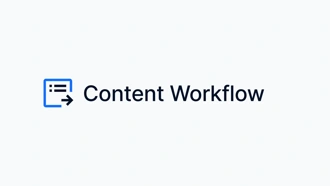We know that brands need to create more content than ever before.
With a larger number of channels for brands to communicate with their customers, there has been a growth in the demand for content that has kept on increasing.
And how are things for those ‘in the weeds’ with content creation right now?
Raise your hand if you’ve ever found yourself:
- In perpetual feedback loops or waiting endlessly for approvals
- Unsure of whether your content was accurate and relevant
- Uncertain if a piece of content was in line with the style guide
- Confused about which team members were responsible for the review and approval process
If you’ve experienced any of the above, read on.
In this blog, we've outlined a simple (and painless) method for effective content reviews, even when multiple team members are involved.
What is a content review?
A content review is the quality assurance process each piece of content should go through before publishing — and periodically thereafter. It can involve everything from checking for audience alignment to ensuring a consistent brand voice to proofreading and beyond.
What’s needed to ensure that this process is comprehensive and consistently optimizes the content you publish?
Below, we’ll cover four steps, along with some best practices worth remembering.
The content review process
1. Define roles and responsibilities for the content review process
Having a well-defined content creation process is one thing (and a good start). But it’s nothing without a clear understanding of who’s responsible for completing the review and approval process.
In the case of reviewing content, the job may fall to:
- Subject matter experts
- Senior editors or editors-in-chief
- Copywriters
- Marketing managers
- Content managers
The task could even be split across several roles. For example, the subject matter experts may check factual accuracy, relevancy, and completeness.
Then, the senior editor may check that the content is well-written, aligned with your content strategy, consistent with other content, and applies the style guide and house rules.
But this is easier said than done.
It can easily take an hour or two to review one decent-sized piece of content—1,500 words, for example. Now, imagine scaling that up to a whole site.
It would be pretty time-consuming, right?
Ultimately, the key is ensuring that someone is responsible for handling the review and approval process (and that they’re clear on where they fit into your workflow).
2. Do a content audit
Once your team is assembled, you can move on to the review itself. Where do you begin?
First, be clear about what to review. Content stalls at the review stages when stakeholders are unclear on their role and the remit of other reviewers. So, create a content inventory — usually a spreadsheet outlining all of your existing content — to assess the current state of play.
From here, you can guide reviewers and get them to ask the right questions about the content they’re responsible for.
3. Define what the content review process looks like
Defining your approach to reviewing content will help you to maintain high-quality content. As far as this goes, there are two main things you need to do.
Create checklists to assist reviewers
Each reviewer on your content team should be guided by some sort of checklist to ensure all content is reviewed properly:
- Does the content sufficiently help meet a validated, priority user need?
- Does it help meet a business communication goal?
- Is it redundant, out-of-date, or trivial content (also known as ‘ROT’ content)?
- Is it at risk of ‘rotting’?
- Is it factually correct, on message, and still saying the most important things?
- Are there any typos, broken links, or poor grammar?
- Does it follow the style guide, including house rules and tone of voice guidelines?
- Is it duplicated elsewhere (word for word or the same topic)?
Be honest when answering these questions. It may be scary to think that you’re creating a lot of work for yourself, but the consequences of out-of-date, poorly-written content only breeds problems later on.




 Bynder’s Content Workflow enables the creation of standardized content review checklists.
Bynder’s Content Workflow enables the creation of standardized content review checklists.
Set review outcomes and next steps
The reviewer should record one of these three decisions for each piece of content they look at:
- Keep: All good with no updates required.
- Keep and revise: Some updates are required to maintain or improve the quality of the content.
- Remove or archive: No longer meeting user needs and business goals. (You may need to archive content, so it’s no longer on the site but still available. There may be a legal requirement to do this.)
If any content gaps reveal themselves during this stage, record those too and add:
- New: New content needs to be written.
Once this task is complete, you can begin to prioritize the content, assign people to it, and get stuck into content creation and/or optimization.
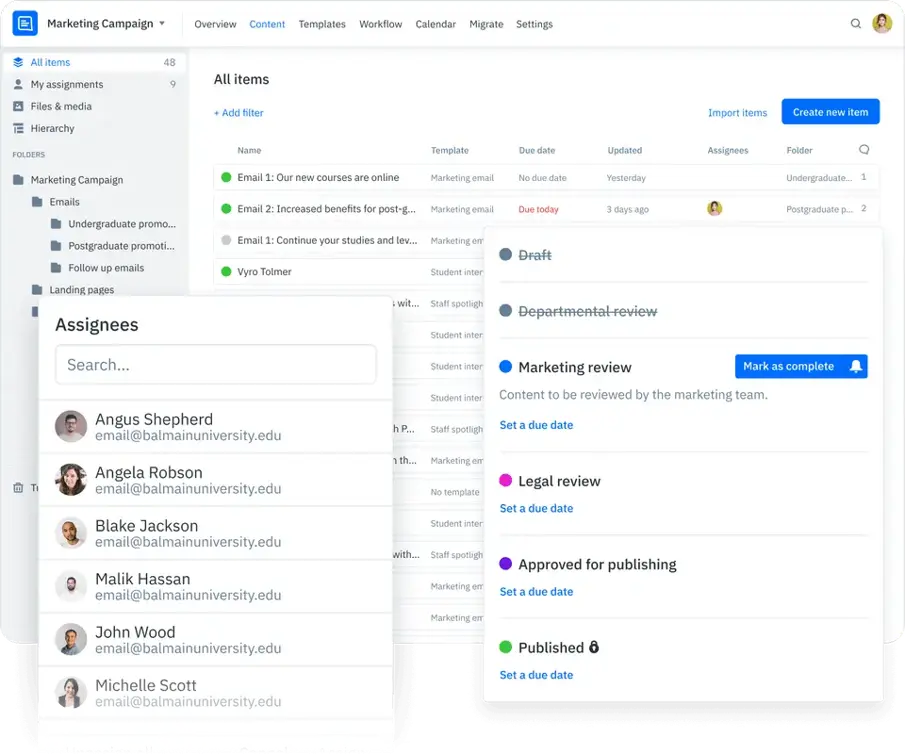
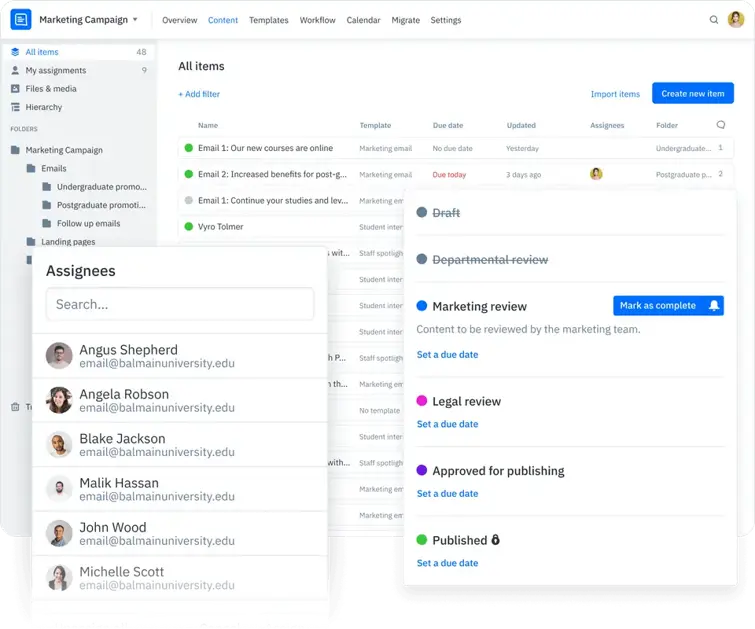
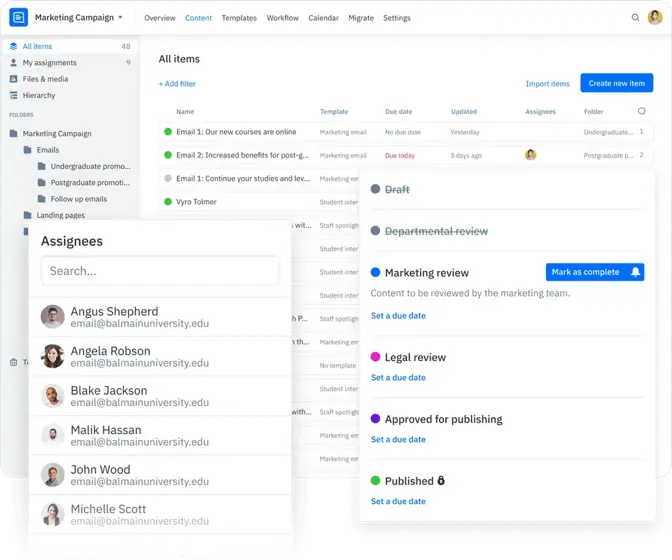
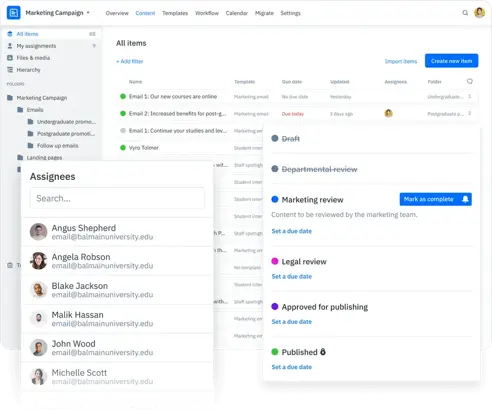
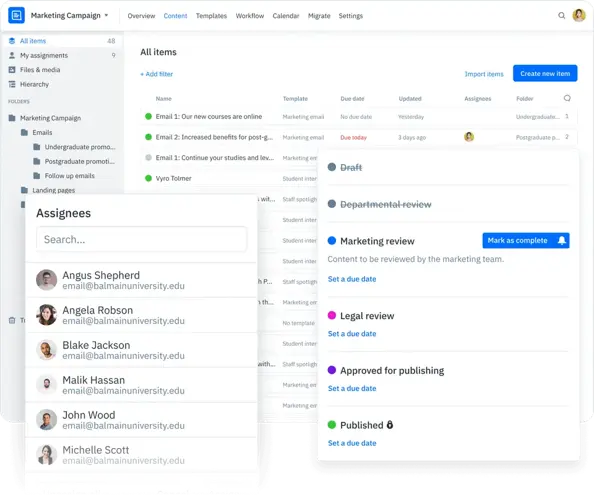 Content Workflow centralizes content teams and workflows.
Content Workflow centralizes content teams and workflows.
Next, you need a way of ensuring and checking content is being reviewed regularly.
4. Apply strict review dates to content
Waiting for someone else to alert you to subpar or outdated content is not a great tactic. Some organizations set different review lengths for different types of content.
A product page may need to be reviewed quarterly, while a company history page may only need to be reviewed annually. This is largely determined by the likelihood of content falling out of date.
Anyone assigned as a reviewer — a subject matter expert, for example — needs to be on board. Ideally, reviewing content should be a formal part of their job description, so it actually happens.
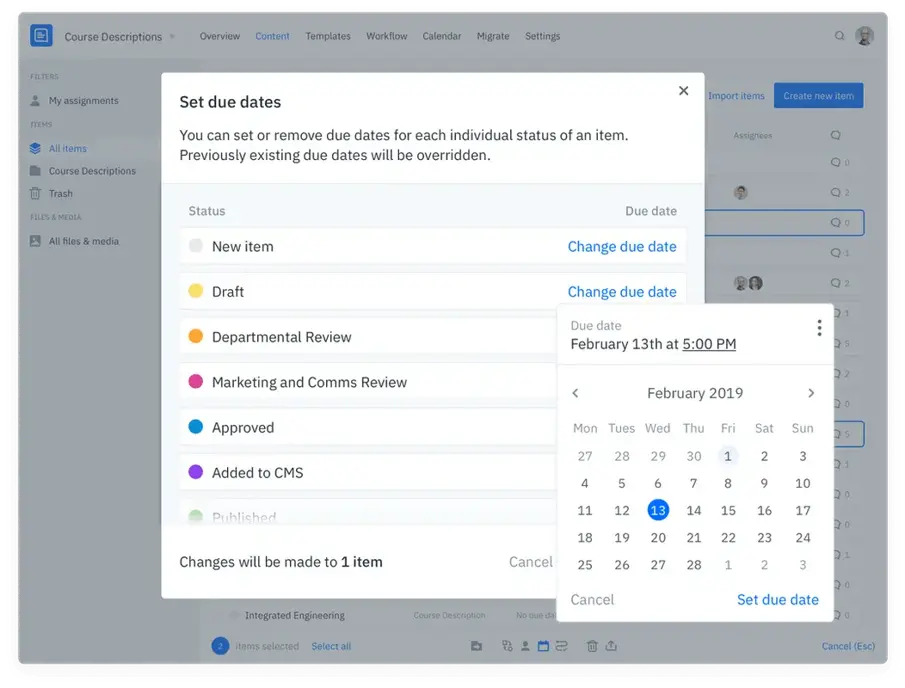
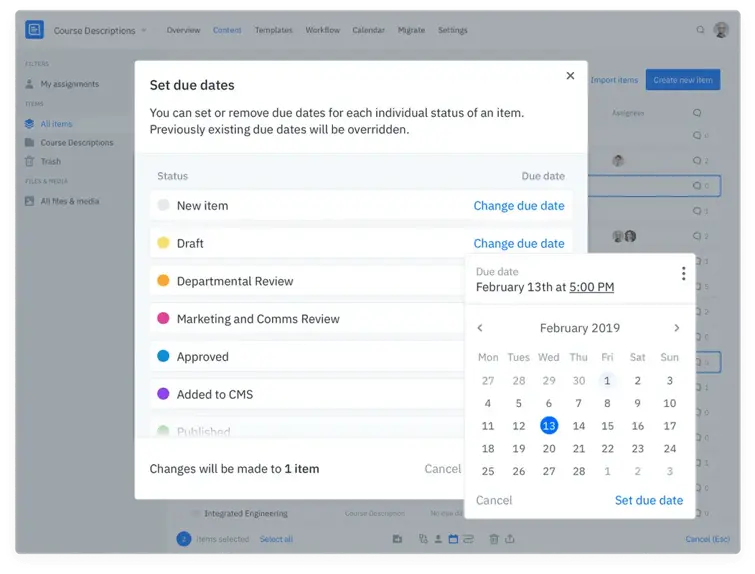
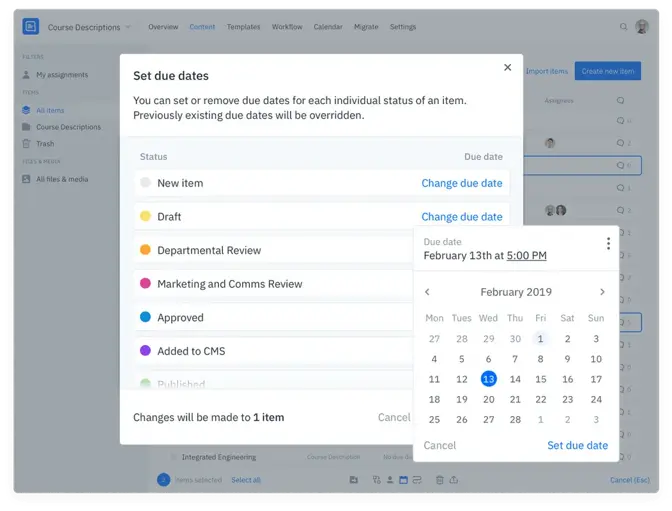
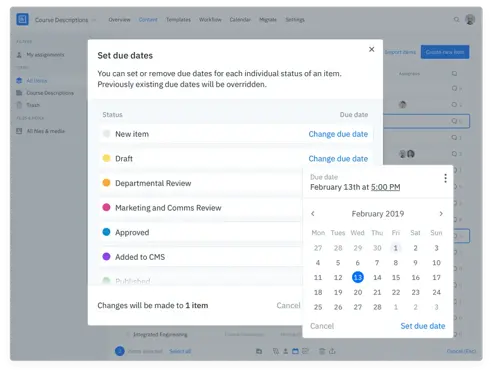
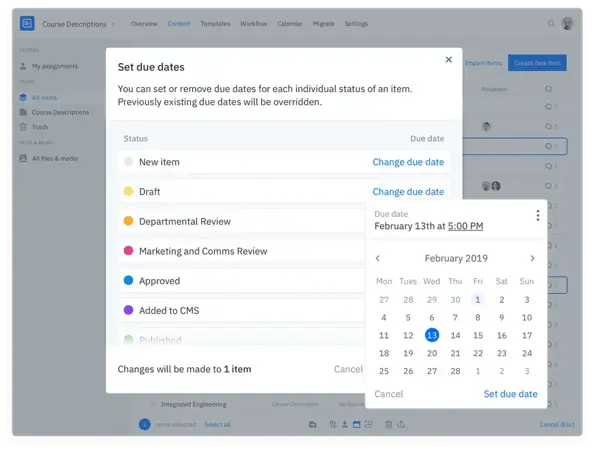 Set due dates in Bynder’s Content Workflow for both content creation and content reviews.
Set due dates in Bynder’s Content Workflow for both content creation and content reviews.
Five best practices for reviewing content
In addition to using checklists and setting strict review deadlines, there are several other best practices you should stick to.
1. Choose reviewers wisely
As mentioned, you may designate several reviewers to participate in the process. But how many is too many?
Richard Lubicky, the founder of RealPeopleSearch, shed some light on the need for balance, saying:
"Keep the number of reviewers as few as possible and as many as necessary.
”By including only key team members in this process, there won't be too many voices weighing in, causing the initial goals of the content to be lost in the noise.
“It will also help to strike the right balance between speed and usefulness, ensuring that your team sticks to the process, rather than being annoyed by the unnecessary delays they would otherwise have caused in your workflow."
2. Revisit your and your audience’s goals
Anders Bryde Thornild, Marketing Manager at CyberPilot makes the point that:
"You can end up focusing on wording and grammar so much that you forget to ask, ‘What does the reader expect to learn from this? And ‘What do we want to tell them?’
”Normally, you know this when you start creating your content, but you may forget it in the review part of the process."
Similarly, we can lose sight of our organizational/internal goals for the content. So it’s helpful to revisit them before and throughout the review.
3. Use a style guide
Ai Hiura, CMO and Chief Editor at FAVERIE, explains the importance of style and editorial guidelines:
"You need a way of ensuring and checking content is being reviewed regularly."
4. Fact-check everything
"Fact-checking and ensuring you have the latest, breaking information is something many creators forget. It can be difficult to understand how accurate and recent data is, so sometimes it’s easy to pull information that's a few years old," says James Persons, Founder and CEO of Content Powered.
“Put that extra effort into ensuring your information is up to date and don’t be afraid to fact-check by getting in touch with an informed source. It’s an extra step and is commonly passed over, but it can really take your content to the next level.”
5. Track changes instead of making direct edits
Cale Loken, CEO of 301 Madison Consulting, offers this advice:
"When editors track edits and add suggestions, it allows them to have a transparent dialogue with content creators. This will enable creators to identify areas of improvement that will lead to better content output in the future.
“On the contrary, if editors make the revisions themselves, the content creators will never learn what they did wrong and continue making the same mistakes repeatedly. This is an efficient work process that wastes a lot of time in the long run."
Start taking content reviews seriously
All your strategy, planning, and hard work can quickly unravel if you ignore content once it’s been published.
So embedding these reviews into your workflow is a good step toward future-proofing your content. To do this, you need to designate content reviewers, audit your content periodically, define and stick to a process for reviewing content, and stick to the review schedule you set.
Bynder’s Content Workflow can simplify this process for you by allowing you to set due dates, assign roles and tasks, and maintain consistency across content formats via templates; not to mention that it makes collaboration a breeze.
All of this can translate directly to increased efficiency and higher-quality content, so why not book a demo to see if Bynder’s Content Workflow would suit your organization’s content creation requirements.















